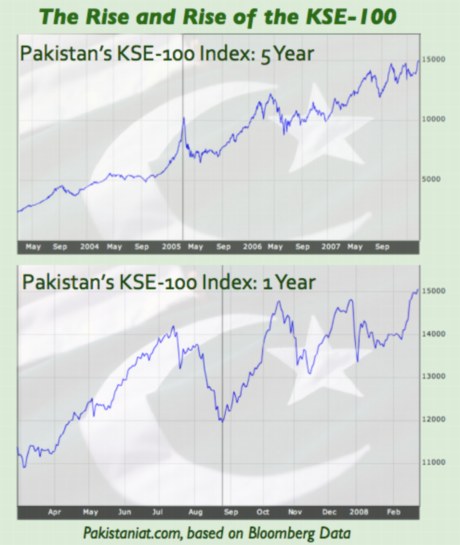Adil Najam
On Tuesday the Karachi Stock Exchange’s (KSE’s) KSE-100 Index – Pakistan’s equivalent to the Dow Jones Index – broke the psychological barrier of 15,000 for the first time. At the time of writing this (on what is Wednesday morning in Pakistan) the Index remains well above that mark.
The rise of the stock market(s) in Pakistan in recent years has been phenomenal. Much of this matches the rise of emerging markets all over the world, but the rise over the last year is particularly phenomenal given just how depressed, depressing, uncertain and unclear the politics of the country has been. My friends who work in the financial sector tell me that money can be made from bad news as much as from good news. I am sure they are right, though I am not sure if I understand all the nuances of how.
 But it still intrigues me why and how the market in an economy like Pakistan – where the stock market itself is rather small in terms of size as well as participation – works in relation to what is happening in the society at large. The charts, and news, clearly indicate that the stock exchange in Pakistan has not been oblivious to the political and socio-economic upheavals of the last many months. But the direction seems to have been clearly upwards and it is not clear just how much of those events are reflected in the market.
But it still intrigues me why and how the market in an economy like Pakistan – where the stock market itself is rather small in terms of size as well as participation – works in relation to what is happening in the society at large. The charts, and news, clearly indicate that the stock exchange in Pakistan has not been oblivious to the political and socio-economic upheavals of the last many months. But the direction seems to have been clearly upwards and it is not clear just how much of those events are reflected in the market.
One is used in larger markets (USA, Europe, Japan) to seeing the happenings in society and politics to have deep and immediate impacts on the market fluctuations. Is it the same in Pakistan? Or is it that because so many fewer people are actually invested in stocks that the stock market’s rhythms are less intertwined with local happenings and more with global and international happenings (especially if much of the capital flow is from international investors)? And, if, indeed, the stock market in Pakistan is as much of a barometer and reflection of what is happening in the country, then what is it that the market has been telling us all year, and is telling us now?
I know that many of our readers have far greater expertise in this area. Maybe they can help me and others decipher the meaning of all of this better.
(Graphs from Bloomberg)




















































I remember a few years ago, when KSE and AKD went online with their 25k max stock playing websites, a lot of people I knew were actively trading daily and KSE/AKD websites were almost always open.
Perhaps, and I’m just speculating, thats when our middle class actually got a taste of it all, and the participation in stocks rose quite a lot. Also even before that, I knew friends, average middle class families, who had somebody in the family in the stock business.
I’m not sure if this is a trend across the board, but if you look at it, stocks do provide an easier mechanism for middle class families to generate some ‘side-income’ apart from trading in lands of course.
The rise and fall of KSE has however, in my opinion, got nothing to do with this. But it maybe a factor in the eyes of the big players.
@Aqil Sajjad
Thank you for sharing your views. Is the situation same in other developing countries such as India or Indonesia as in Pakistan or is it more like the Western world? I mean the ratio of market capitalization to GDP?
Dear Ahmad Shahid:
I think the difference between Pakistan and well developed economies is that a lot of middle class people also invest in the stock exchange in developed countries. This is in sharp contrast to Pakistan where the stock exchanges are dominated by a very small number of investors and even the vast majority of the middle class stays away. Secondly, since a majority of Pakistanis do not even earn 2 dollars a day, we are in no position to have market capitalization close to the gdp the way some developed countries have. In other words, the fundamentals of our economy suggest that our stock exchange capitalization should be well below the percentage of gdp that one would find in developed countries.
If you look at the 5 year trend, the graph is cumulatively going up and up therefore i don’t think any current happening affected the larger trend except for a peak here and a dip there.
Is it that the KSE is also celebrating the outcome of the elections in Pakistan?